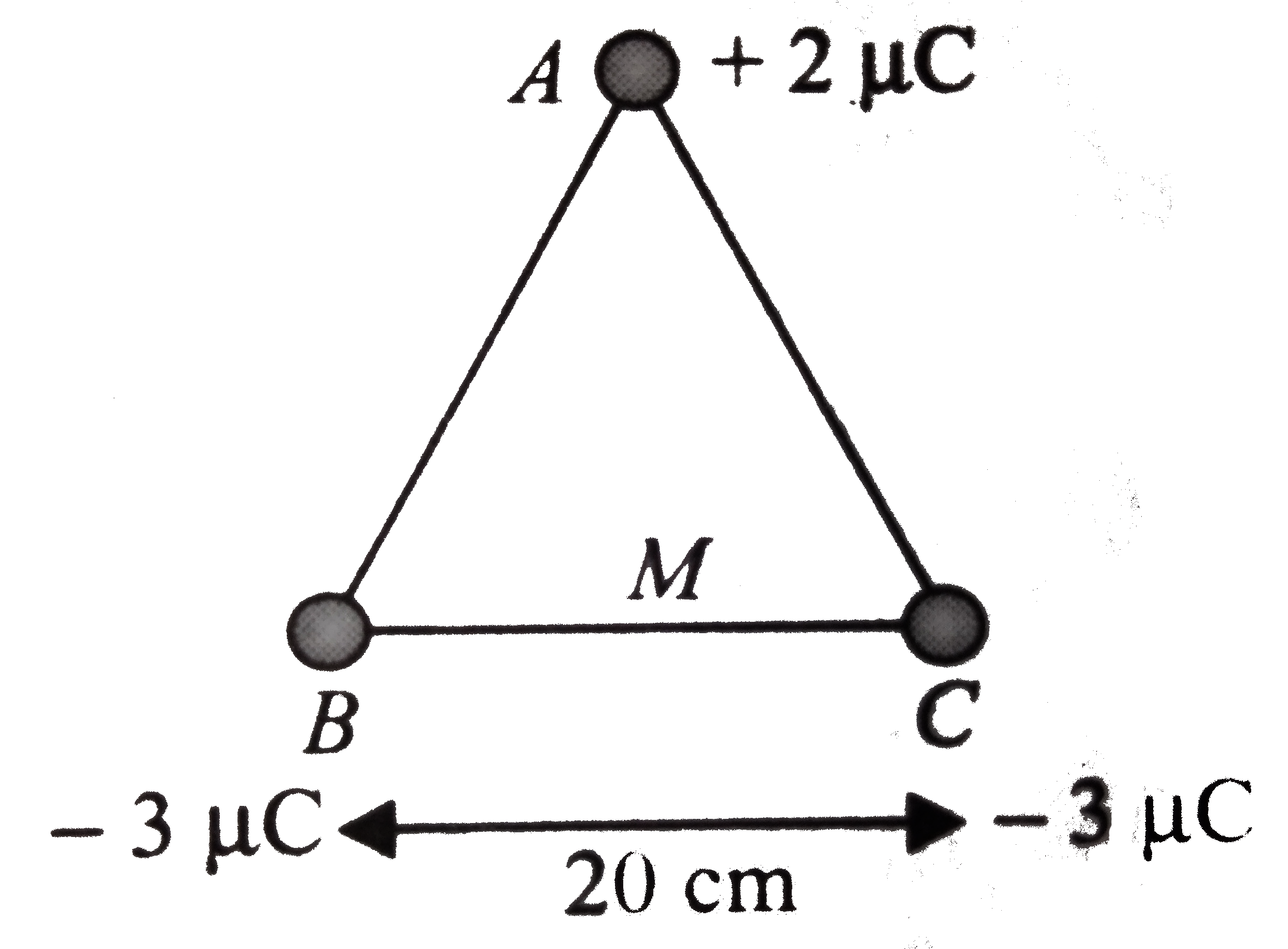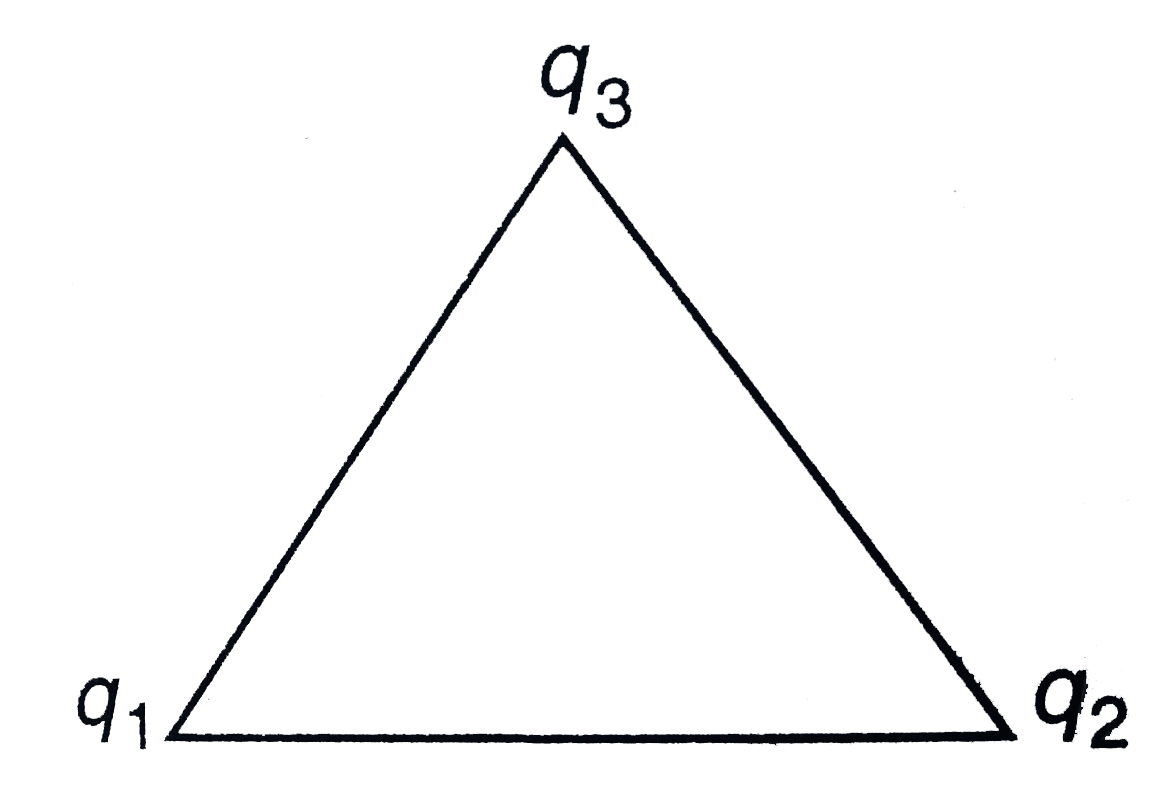Three point charges Q1=25μC,Q2=50μC and Q3=100μC, are kept at the corners A, B and C respectively of an equilateral triangle ABC having each side equal to 7.5 m. Calculate the total electrostatic potential energy of the system.
To calculate the total electrostatic potential energy of the system of three point charges placed at the corners of an equilateral triangle, we can follow these steps:
Step 1: Identify the Charges and Distance
We have three point charges:
- Q1=25μC=25×10−6C
- Q2=50μC=50×10−6C
- Q3=100μC=100×10−6C
The distance between each pair of charges (sides of the triangle) is:
- r=7.5m
Step 2: Use the Formula for Electrostatic Potential Energy
The total electrostatic potential energy U of a system of point charges is given by the formula:
U=k(Q1Q2r+Q2Q3r+Q3Q1r)
where k=14πϵ0≈9×109Nm2/C2.
Step 3: Substitute the Values into the Formula
Substituting the values into the formula:
U=9×109((25×10−6)(50×10−6)7.5+(50×10−6)(100×10−6)7.5+(100×10−6)(25×10−6)7.5)
Step 4: Calculate Each Term
1. First term:
(25×10−6)(50×10−6)7.5=1.25×10−97.5=1.6667×10−10J
2. Second term:
(50×10−6)(100×10−6)7.5=5×10−97.5=6.6667×10−10J
3. Third term:
(100×10−6)(25×10−6)7.5=2.5×10−97.5=3.3333×10−10J
Step 5: Sum the Terms
Now, summing all the terms:
U=9×109(1.6667×10−10+6.6667×10−10+3.3333×10−10)
U=9×109(1.1111×10−9)=10.0J
Final Answer
The total electrostatic potential energy of the system is approximately:
U≈10.0J
We have three point charges:
- Q1=25μC=25×10−6C
- Q2=50μC=50×10−6C
- Q3=100μC=100×10−6C
- r=7.5m
The total electrostatic potential energy U of a system of point charges is given by the formula:
U=k(Q1Q2r+Q2Q3r+Q3Q1r)
where k=14πϵ0≈9×109Nm2/C2.
Substituting the values into the formula:
U=9×109((25×10−6)(50×10−6)7.5+(50×10−6)(100×10−6)7.5+(100×10−6)(25×10−6)7.5)
1. First term:
(25×10−6)(50×10−6)7.5=1.25×10−97.5=1.6667×10−10J
(50×10−6)(100×10−6)7.5=5×10−97.5=6.6667×10−10J
(100×10−6)(25×10−6)7.5=2.5×10−97.5=3.3333×10−10J
Now, summing all the terms:
U=9×109(1.6667×10−10+6.6667×10−10+3.3333×10−10)
U=9×109(1.1111×10−9)=10.0J
The total electrostatic potential energy of the system is approximately:
U≈10.0J
Similar Questions
Electric charge of 1μC,−1μC and 2μC are placed in air at the corners A, B and C respectively of an equilateral triangle ABC having length of each side 10 cm. The resultant force on the charge at C is
View SolutionThree equal charges of 5.0μC each are placed at the three vertices of an equilateral triangle of side 5.0cm each. Calculate the electrostatic potential energy of the system of chages.
View Solution
Knowledge Check
- Question 1 - Select One
A point charge .q. is kept at each of the vertices of an equilateral triangle having each side .a.. Total electrostatic potential energy of the system is:
A(14πε0)3q2a2B(14πε0)3qaC(14πε0)3q2aD(14πε0)3qa2
Three point charges of +2μC,−3μC , and −3μC are kept at the vertices A, B, and C, respectively of an equilatreral triangle of side 20 cm. what should be the sign and magnitude of the charge (q) to be placed at the midpoint (M) of side BC so that the charge at A remains in equilibrium?
 View Solution
View SolutionThree point charges of +2q,+2qand−4q are placed at the corners A, B and C of an equilateral triangle ABC of side x. The magnitude of the electric dipole moment of this system is ?
View SolutionTwo point charges of 10 C each are kept at a distance of 3 m in vacuum. Calculate their electrostatic potential energy.
View SolutionPoint charge q1=2μC and q2=−1μC are kept at points x=0 and x=6 respectively. Electrical potential will be zero at points
View SolutionThree point charge q1=1μC,q2=−2μC and q3=3μC are placed at (1m,0,0),(0,2m,0) and (0,0,3m) respectively. Find the electric potential at as origin.
View SolutionThree charges q1=1μC,q2=2μC and q3=3μC are placed on the vertices of an equilateral triangle of side 1.0 m. Find the net electric force acting on charge q1
 View Solution
View SolutionThree charges Q,(+q) and (+q) are placed at the vertices of an equilateral triangle of side l as shown in the figure. It the net electrostatic energy of the system is zero, then Q is equal to
 View Solution
View Solution

